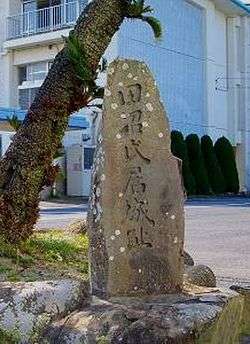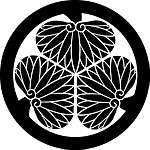Sagara Domain

Sagara Domain (相良藩 Sagara-han) was a Japanese feudal domain under the Tokugawa shogunate of Edo period, located in Tōtōmi Province. The domain was centered in what is now the Sagara district of Makinohara city, Shizuoka Prefecture.[1] The site of the Sagara [jin'ya] is now the Sagara Elementary School.
History
In 1710, Honda Tadaharu, lord of Ibo Domain in Mikawa Province was transferred by the Tokugawa shogunate to Sagara, on the coast of Tōtōmi Province and his revenues were raised from 10,000 koku to 15,000. The Honda clan ruled Sagara for three generations, until Honda Tadayuki was transferred to Izumi Domain in Mutsu Province in 1746.
The Honda were replaced by Itakura Katsukiyo, who ruled for only three years before being transferred to Annaka Domain in Kozuke Province. Sagara was then returned to the Honda clan in the form of Honda Tadanaka, formerly of Komoro Domain in Mikawa; however, it was reclassified as only a minor 10,000 koku domain at this time.
In 1767, Sagara Domain was awarded to Tanuma Okitsugu, who rose from very humble status as a page to Shōgun Tokugawa Ieshige, to chamberlain, and then grand-chamberlain and rōjū under Shōgun Tokugawa Ieharu. He was also elevated to the status of daimyō when he was awarded Sagara Domain, and over the years increased its revenues from 10,000 koku to 57,000 koku. Sagara prospered greatly under his economic reforms, and a road was built linking it to the great Tōkaidō highway. However, after Tokugawa Ieharu’s death Tanuma Okitsugu was soon in disfavor, and reduced in rank and income. His grandson, Tanuma Okiaki, inherited a domain reduced back to its former 10,000 koku status in 1787, and less than a year later, was transferred to Shimomura Domain in Mutsu Province. Sagara Domain became a tenryō territory ruled directly by the Shōgun.
However, in 1823, his son Tanuma Ogimasa was allowed to return to Sagara, where he and his descendents remained until the Meiji Restoration. The domain had a population of 310 samurai at the start of the Meiji period. The domain maintained its primary residence (kamiyashiki) in Edo at Kanda, until the An'ei (1772–81) period, and at Hanjo at the time of the Meiji restoration.[2]
In February 1869, the final daimyō of Sagara Domain, Tanuma Okitaka was transferred by the new Meiji government to the short-lived Okubo Domain in Kazusa Province and Sagara Domain was absorbed into the new Shizuoka Domain created for retired ex-Shōgun Tokugawa Yoshinobu.
List of daimyo
# Name Tenure Courtesy title Court Rank kokudaka  Honda clan, 1710-1746 (fudai)
Honda clan, 1710-1746 (fudai) 1 Honda Tadaharu (本多 忠晴) 1710–1715 Danjō-Shōhitsu (弾正少弼) Lower 5th (従五位下) 15,000 koku 2 Honda Tadamichi (本多忠通) 1715–1721 Danjō-Shōhitsu (弾正少弼) Lower 5th (従五位下) 15,000 koku 3 Honda Tadayuki (本多 忠如) 1721–1746 Etchu-no-kami (越中守) Lower 5th (従五位下) 15,000 koku  Itakura clan 1746-1749 (fudai)[3]
Itakura clan 1746-1749 (fudai)[3] 1 Itakura Katsukiyo (板倉 勝清) 1746–1749 Sado-no-kami (佐渡守); Jijū (侍従) Lower 4th (従四位下) 20,000 koku  Honda clan 1749-1758 (fudai)[4]
Honda clan 1749-1758 (fudai)[4] 1 Honda Tadanaka (本多 忠央) 1749–1758 Nagato-no-kami (長門守) Lower 5th (従五位下) 10,000 koku  Tanuma clan , 1772-1787 (fudai)[5]
Tanuma clan , 1772-1787 (fudai)[5] 1 Tanuma Okitsugu (田沼 意次) 1767–1786 Tonomori-ryō (主殿寮); Jijū (侍従) Lower 4th (従四位下) 10,000 – 57,000 – 10,000 koku 2 Tanuma Okiaki (田沼意明次) 1767–1786 Shimosuke-no-kami (下野守) Lower 5th (従五位下) 10,000 koku  Tenryō 1786-1823
Tenryō 1786-1823 Tanuma clan 1823-1868 (fudai)[1]
Tanuma clan 1823-1868 (fudai)[1]1 Tanuma Okimasa (田沼意正) 1823–1836 Genba-no-kami (玄蕃頭) Lower 4th (従四位下) 10,000 koku 2 Tanuma Okitome (田沼意留) 1836–1840 Echizen-no-kami (備前守) Lower 5th (従五位下) 10,000 koku 3 Tanuma Okitaka (田沼意尊) 1840–1868 Genba-no-kami (玄蕃頭) Lower 5th (従五位下) 10,000 koku
Holdings at the end of the Edo period
- Tōtōmi Province
- 28 villages in Haibara District
- 12 villages in Kitō District
See also
References
- Papinot, E (1910). Historical and Geographic Dictionary of Japan. Tuttle (reprint) 1972.
External links
- "Sagara" at Edo 300 (Japanese)
- Makinohara City home page
Notes
- 1 2 "Tōtōmi Province" at JapaneseCastleExplorer.com; retrieved 2013-6-11.
- ↑ Edo daimyo.net (Japanese)
- ↑ Papinot, Jacques Edmond Joseph. (1906). Dictionnaire d’histoire et de géographie du Japon; Papinot, (2003). "Itakura" at Nobiliare du Japon, p. 17; retrieved 2013-6-11.
- ↑ Papinot, (2003). "Honda" at Nobiliare du Japon, p. 10; retrieved 2013-6-11.
- ↑ Papinot, (2003). "Tanuma" at Nobiliare du Japon, p. 60; retrieved 2013-6-11.